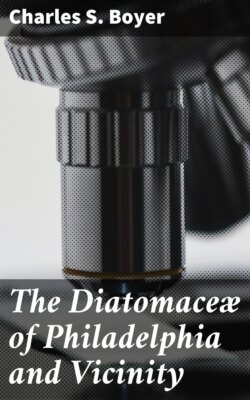Читать книгу The Diatomaceæ of Philadelphia and Vicinity - Charles S. Boyer - Страница 7
На сайте Литреса книга снята с продажи.
THE CELL
ОглавлениеTable of Contents
The cell membrane is composed of two usually equal parts, each of which consists of a valve and a girdle or zone formed of cellulose modified by silica deposited in an insoluble state from a very dilute aqueous solution. The valves are more siliceous and robust than the girdle. Both are in most species easily separable, or at least the bands of the girdle which may be more or less closely fastened to the valves have a motion over each other permitting the cell to enlarge at pleasure. The longitudinal diameter of the cell, or the distance between the centres of the two valves, will vary according to the convexity of the valve and the age of the frustule which may be often determined by the width or number of the girdle bands. These, owing to their diversity of form and arrangement, will be further described under the generic diagnoses.
The siliceous cell-wall is covered on the outside by a layer of protoplasm called the coleoderm. This layer may be quite thin and evident only when treated with fuchsin or Bismarck brown, or it may be of considerable thickness. The cell contains the cytoplasma, protoplasm, cell-sap, endochrome, pyrenoids, oil globules and nucleus, together with certain other less understood bodies.
The Cytoplasma is a thin skin of colorless plasma covering the entire inner surface of the cell. It is invisible in the living cell but is evident in plasmolysis. In long forms it is thickened at the ends and is condensed at the plasma bridge which frequently connects the two valves and divides the cell into two parts, each containing more or less protoplasm surrounding the vacuole in which are found the cell-sap and certain granules. In some forms, as Meloseira, the cytoplasma includes the entire mass of protoplasm.
The Endochrome is seen in the form of one or more bands or plates, of a yellowish or brownish color, on the inner side of the valves or connective zone, or in granules or irregular masses, more or less numerous, on the inner walls, or sometimes grouped near the centre. It consists of a mixture of chlorophyll and diatomine which differ in their relative solubility in alcohol and in their spectroscopic analyses. The color varies from green to a chocolate brown in proportion to the amount of diatomine. So far as the function of the endochrome is concerned it does not appear to differ from that of ordinary chlorophyll, absorbing, under the influence of light, the carbon, and disengaging the oxygen of the carbonic anhydride in the water. Diatoms do not live in absolutely pure or non-aërated water. The individual plates or granules of the endochrome are called chromatophores. Their number and significance will be referred to in the description of genera.
The Pyrenoids.—In the chromatophores of many species are found colorless, homogeneous bodies, strongly refractive, of various shapes, usually lenticular or fusiform, which are known as Pyrenoids (Schmitz). They are scarcely evident in the living cell, but are distinguished by the action of hæmatoxylin and other reagents. Flat forms occur in Surirella and Pleurosigma, lens forms in Pinnularia, Stauroneis, Synedra, Fragilaria and Nitzschia, while a spherical form is found in Cymbella cuspidata. The pyrenoids are always imbedded in the chromatophore. Their growth is by division. Schmitz considers them a part of the living chromatophore, and their substance as working material which in excess has become resolved into the nature of a crystal which its form sometimes resembles. Comparisons are made between them and crystalloids found in certain monocotyledons. The pyrenoid is evidently concerned in the formation of the chromatophore, or in its division. Much of the conjecture, however, is due to the behavior of pyrenoids in other plants.
Oil Globules.—It has been established by Pfitzer that starch and sugar, as assimilation products, are replaced by oil in the cells of diatoms ("da bekannlich Staerke und Zucker bei den Bacillariaceen nicht nachzuweisen sind"). The oil drops are more or less numerous, of various sizes, and are found in the cytoplasma, the cell-sap, and sometimes the chromatophores. Mereschkowsky describes certain globules as elæoplasts, which he divides into four kinds according to their number and position. Whether all of these are oil globules is a question not yet determined.
Other bodies, known as "Buetschli granules," or volutin, and described as "little blisters filled with a tolerably robust refractive substance," are considered by Lauterborn to be a nitrogen reserve store. They are found in the cytoplasma, or in the cell-sap, and can be fixed in picric acid and stained in methylene blue.
Note.—For a discussion of the morphology of diatoms and a valuable résumé of the investigations of Buetschli, Karsten, Lauterborn, Mereschkowsky, Mueller, Pfitzer, Schuett, and others, the student is referred to "Der Bau der Diatomzelle," by Dr. Otto Heinzerling, in "Bibliotheca Botanica," 1908.
